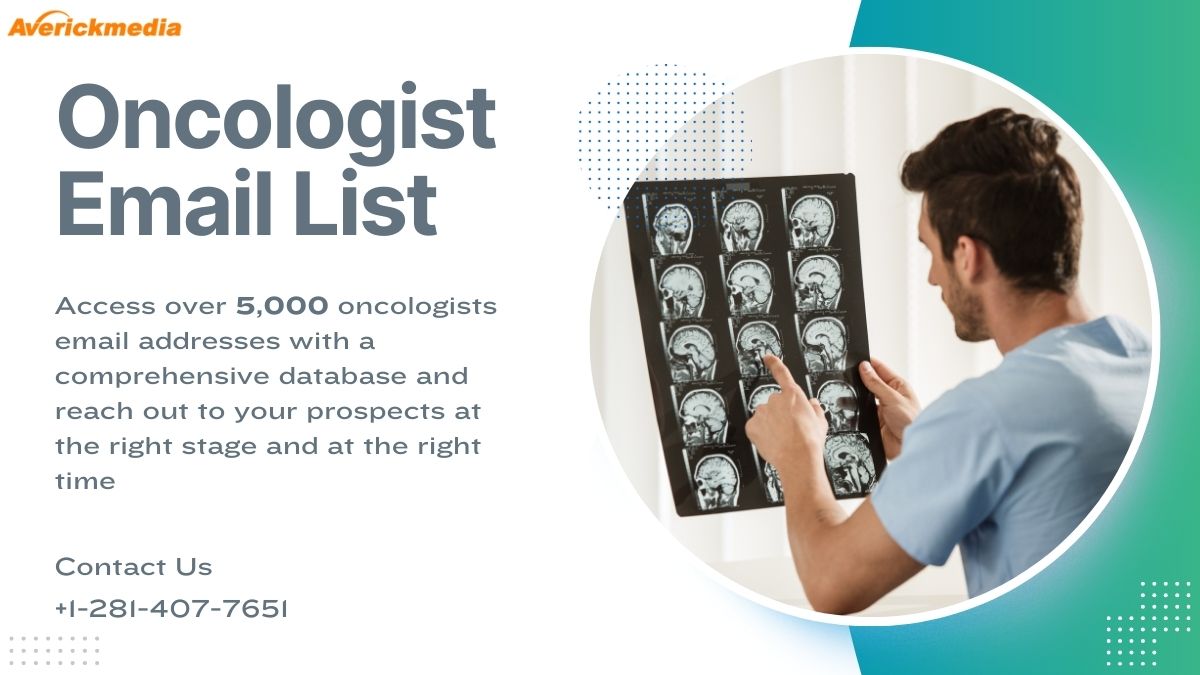Introduction
Are you looking to reach out to oncologists using email lists? If so, this blog post is for you! Here, we will discuss the top 5 business tricks for targeting oncologists with an Oncologist Email List. We’ll cover the best ways to find an up-to-date list of oncologists, which list building techniques work best, and how to ensure your emails get noticed. Additionally, we’ll discuss the importance of segmenting your Oncologist Email List and the benefits of personalizing your messages. So, let’s get started!
1) Identifying the Right Oncologist Email List
When it comes to targeting oncologists with an email campaign, the first and most crucial step is identifying the right oncologist email list. You want to make sure you have access to a high-quality and up-to-date list that includes the contact information of oncologists who are actively practicing in your desired region. This will ensure that your messages are reaching the right audience and increase the likelihood of a positive response.
One effective way to obtain an accurate oncologist email list is through a reputable provider of oncologist mailing lists. These providers specialize in collecting and maintaining comprehensive databases of oncologists’ contact information. They have access to a wide network of sources, including medical associations, hospitals, and professional directories, which ensures that their lists are accurate and up-to-date.
When choosing a provider, look for one that offers customizable options, allowing you to target specific criteria such as location, specialty, and years of experience. This will enable you to narrow down your audience and tailor your message to resonate with your target oncologists. Additionally, consider the provider’s reputation and customer reviews to ensure that they deliver reliable and high-quality lists.
By starting with the right oncologist email list, you lay the foundation for a successful email campaign that reaches the right professionals and increases your chances of achieving your desired outcomes. So take the time to research and choose a reputable provider, and you’ll be well on your way to reaching out to oncologists effectively.
2) Creating Compelling Email Content
When it comes to reaching out to oncologists through email, the content of your messages is crucial. Creating compelling email content is key to capturing the attention of busy oncologists and increasing the likelihood of a positive response. Here are a few tips to help you craft engaging and impactful emails.
First, start by understanding your target audience. By utilizing an accurate and up-to-date oncologist mailing list, you can gather valuable insights into the preferences, challenges, and interests of oncologists. Use this information to tailor your email content specifically to their needs and concerns. Addressing their pain points and offering solutions will make your emails more relevant and valuable.
Next, focus on creating clear and concise messages. Oncologists receive a large volume of emails every day, so it’s important to make your content easy to skim and digest. Use short paragraphs, bullet points, and headings to break up the text and make it more scannable. This will help oncologists quickly understand the key points of your email and increase the chances of them reading it in its entirety.
Additionally, use a personalized approach when crafting your email content. Addressing oncologists by their name and referencing their specific specialty or location can help create a connection and make your email feel more personalized. This personal touch can significantly improve response rates and engagement.
Finally, don’t forget to include a clear call to action (CTA) in your emails. Whether you want oncologists to register for a webinar, download a whitepaper, or schedule a meeting, make it easy for them to take the desired action. Use a prominent CTA button and include a brief, compelling statement that clearly outlines the benefits of taking action.
By following these tips, you can create compelling email content that resonates with oncologists, grabs their attention, and drives them to take action. Remember to always test and optimize your email content to continuously improve your results. Good luck!
3) Timing Your Email Campaigns Strategically
Timing your email campaigns strategically is a crucial aspect of reaching oncologists effectively. Sending your emails at the right time can significantly impact their open rates, click-through rates, and overall success. Here are some tips for timing your email campaigns strategically using an Oncologist Mailing List.
First, consider the time of day and day of the week when oncologists are most likely to check their emails. Keep in mind their busy schedules and try to avoid sending emails during their peak patient hours. Early mornings or late afternoons may be ideal times to catch them when they have some downtime.
Next, take into account any important industry events or conferences that may be happening. Avoid sending emails during these times as oncologists may be preoccupied and less likely to engage with your messages. Conversely, you can leverage these events by sending relevant emails leading up to or during the event to generate interest and drive attendance.
Furthermore, consider the frequency of your email campaigns. Bombarding oncologists with emails too frequently can lead to annoyance and cause them to unsubscribe. On the other hand, spacing out your emails too much can result in them forgetting about your company or losing interest. Finding the right balance is essential.
Finally, track and analyze the performance of your email campaigns using metrics such as open rates, click-through rates, and conversions. This data will provide valuable insights into the effectiveness of your timing strategy. Experiment with different timing options and optimize your campaigns based on the results.
By strategically timing your email campaigns, you can increase the chances of your messages being seen and engaged with by oncologists. Use the insights from your Oncologist Mailing List and monitor your campaign metrics to refine your timing strategy over time.
4) Personalizing Your Emails for Better Response Rates
Personalizing your emails is a crucial strategy for increasing response rates and engagement from oncologists. By tailoring your messages to the specific needs and interests of each individual, you can create a connection and make your emails feel more relevant and valuable. Here are a few tips to help you personalize your emails and improve your response rates.
First, address oncologists by their name. Using a personal salutation instead of a generic greeting instantly grabs their attention and shows that you have taken the time to research and understand who they are. It adds a human touch to your emails and makes them feel more personalized.
Next, reference their specific specialty or location. By acknowledging their expertise or their practice area, you demonstrate that you have done your homework and are aware of their specific needs and challenges. This shows that you have something valuable to offer and makes your emails more appealing.
Furthermore, consider including relevant content or resources in your emails. Whether it’s a recent study, a new treatment option, or an industry report, providing valuable information that aligns with their interests and concerns will capture their attention and make them more likely to engage with your emails.
Finally, use data from your oncologist email list to segment your audience and send targeted, personalized messages. Segmenting your list based on criteria such as location, specialty, or years of experience allows you to tailor your emails even further and deliver more relevant content to each recipient.
By personalizing your emails, you can stand out from the competition, build relationships with oncologists, and increase your chances of achieving your desired outcomes. Remember, it’s the little personal touches that make a big difference in email marketing.
5) Optimizing Your Email Subject Lines and CTA Buttons
When it comes to email marketing, your subject lines and call-to-action (CTA) buttons play a crucial role in determining the success of your campaigns. In this section, we will discuss the importance of optimizing your email subject lines and CTA buttons to increase open rates and encourage engagement.
Let’s start with subject lines. Your subject line is the first thing oncologists see in their inbox, so it needs to grab their attention and entice them to open your email. Keep your subject lines short and concise, ideally under 50 characters, to ensure they are fully visible on mobile devices. Use strong, action-oriented language and include keywords that resonate with oncologists, such as “latest research” or “innovative treatment options”. Personalization is also key – include the recipient’s name or reference their specific specialty to make the email feel more personalized.
Moving on to CTA buttons, these are the links or buttons that encourage oncologists to take action in your emails. Make your CTA buttons prominent and easy to find, using contrasting colors and clear, compelling text. Instead of generic phrases like “click here”, use action-oriented and benefit-driven statements such as “Learn more about groundbreaking research” or “Schedule a consultation now”. Also, consider the placement of your CTA buttons – position them prominently in the email and repeat them throughout the message to increase the chances of clicks.
By optimizing your email subject lines and CTA buttons, you can capture the attention of oncologists, drive them to open your emails, and encourage them to take the desired actions. Experiment with different approaches, test your subject lines, and analyze your email metrics to continually refine and improve your results.
Read this – 5 Game-Changing Optometrist Email List Strategies For The Future





